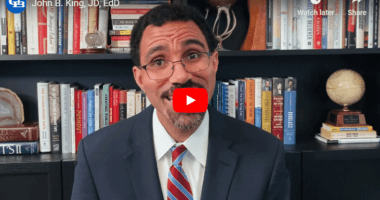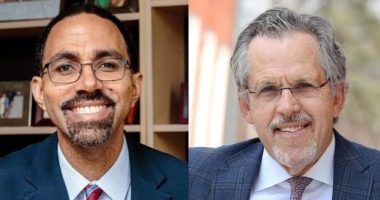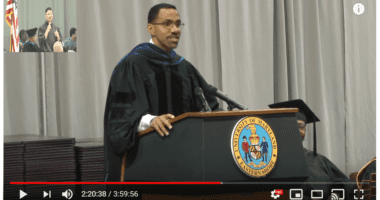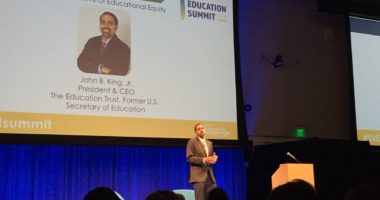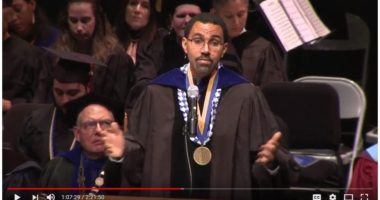John B. King Jr. Addresses Urban Alliance on Commitment to Using Innovation and Evaluation
Good morning everyone. Thanks so much Dan. Thank you to the Urban Alliance for inviting me here today. So, this morning I want to talk about the three R’s. But not reading, writing and arithmetic, although as a teacher and principal, I know those are quite important. But rather what Bill Daggett and others would call rigor, relevance, and relationships. And I want to suggest that our progress in education is connected not only to how well we do with the three R’s of reading, writing, and arithmetic, but also how well we do with the three R’s of rigor, relevance, and relationships. And Urban Alliance and others in the room who are focused on creating those kinds of experiences for our students point the way. Now we’ve made a lot of progress and it’s important, particularly at these moments where we see everyday, the challenges we face, it’s important that we acknowledge the progress we’ve made towards an education that guarantees rigor, relevance, and relationships for students.
I think about the progress we’ve made as a country toward expanding access to quality early learning. The fact that more than 40 states are deeply engaged in the work of raising their standards to ensure college and career readiness. The fact that high schools all across the country are paying attention in ways that they haven’t in the past to early indicators that kids are getting off track. Things like chronic absenteeism or early credit accumulation. And they’re using that information not only to identify students in need of support, but actually to provide meaningful interventions to help those students stay in school. And we’re seeing the consequences of that in lower dropout rates. We’re also seeing more African-American and Latino students go on to college. That’s all important progress to celebrate.
And yet everyone is here because we also are very conscious of the challenges we face. Challenges that begin with the fact that we give the kids who need the most, so often in our society, the least. We give the kids who need the most, less access to effective teachers. Less access to advanced course work, whether that’s AP classes or quality career and technical education. Less access to school counselors. Less access to a well-rounded education that includes science, social studies, and the arts. Less access to resources. And those opportunity gaps then translate into achievement gaps that we see on every indicator, whether we’re talking about the National Assessment of Educational Progress or state tests or high school graduation rates or college matriculation or college completion. Again and again we see gaps for our low income students or students of color, our English Learners, our students with disabilities. In fact, when you look at college completion, for every 10 African-American students that start college, 6 years later only 4 have graduated. For Latino students, only about 5. For white students, only about 6. We are not doing well enough as a country in ensuring the kind of rigor, relevance, and relationships that will deliver students to college and career success. It’s not just a school problem, this is also an economic problem.
You know from the white paper that released today that we have 5 million young people 16-24 who are not in school and they are not working. They are disconnected. They are disengaged. And they are disadvantaged. And we know the consequences, the white paper points out, that there’s a trillion dollar cost to our national economy as a result of these disconnected youth, these opportunity youth. And we know too often those young people who are disengaged from school and work are more likely to end up incarcerated. More likely to end up reliant on social services. We all have a stake in doing better and meeting these collective challenges. Indeed today, majority of the kids in our nation’s public schools are kids of color. Majority of the kids in our nation’s public schools are eligible for free or reduced priced lunch. If we fail as a society to educate low-income students, students of color, English Language Learners, we have no future. Our economy has no future. Our democracy has no future. That’s what’s at stake.
So then we ask, well what do we know about what works? What do we know about what can make a difference? Well we know, we’re gathered here today, that programs like Urban Alliance can make a difference because they are doing those very things that we know are necessary around rigor, relevance, and relationships. Think about the idea that what the Urban Alliance is doing for young people is helping them gain meaningful skills that will allow them to succeed in careers. They are serious about skills. Sometimes people refer to some of the employability skills as soft skills, but that may send the wrong message that they are somehow less worthy because they’re soft. No, they are essential. Who among us would be able to keep our jobs if we didn’t know how to collaborate with peers? If we didn’t know how to do problem solving. If we didn’t know how to persevere through a challenge. Those employability skills are essential. They are the definition of rigor.
Relevance is clear when you talk to the young people who are involved with the Urban Alliance. What you hear is the connection between their internship experience and their vision of their own future. And when it comes to relationships, it’s not just about the relationship with the program coordinator or the mentor in the workplace, it’s that those relationships are enduring, not just short term. And those relationships are meaningful, the business partners here understand. Those relationships are meaningful not just for the students who are participating in the internship, but for the employees of the business partners. I was reading the story of AlexRenew, the Alexandria business that does water treatment, talking about how participating in Urban Alliance raised their employee morale. Because people want relationships. People want to be a part of helping young people to succeed. We know that this kind of rigor, relevance, and relationship work is essential because if it doesn’t happen, kids get off track.
Think about the Gallup Poll which shows us how student engagement drops precipitously from grade 5 to grade 12. Yes, fifth graders trying to say fifth grade engagement with school, about 75% of students are meaningfully engaged in school. But by 12th grade that drops to 34%. And those of us who’ve worked with high school students know what this looks like. Sometimes it’s the kid who gets in trouble over and over again. Gets disciplined. Is disruptive. Gets sent home. Gets sent away. And that kid then enters into the school to prison pipeline. Sometimes being disconnected looks like missing class. Maybe a period or two. Maybe you come late, maybe you leave early. Maybe you miss a day a week, two days a week. And then those students fade away. Sometimes being disconnected happens while in school. Sometimes it’s high school kids who just don’t see the connection between what they’re doing in the classroom and any vision for their future. And so yeah, maybe they show up. Maybe they even get a high school diploma. But they aren’t leaving with the skills they need for postsecondary success. And they aren’t leaving with a plan for what they’re going to do next. That’s the challenge that we need to respond to collectively.
The Urban Alliance RCT results are exciting because it shows us that for the young men involved that completed the program, not only are their indicators around career readiness better, they’re actually going on to college at a 23% higher rate. Urban Alliance is demonstrating that it is not a question of college or career readiness, it’s college and career. It’s not a question of academic skills or socioemotional skills like problem solving, collaboration, it’s both and. It’s not a question of do you get a job that just pays a little money after school or in the summer or are you on a career pathway. You can do both. You can create opportunities for young people, have meaningful work experiences that connect with their long term plan.
Now the white paper and the panel discussion will illustrate there’s lots of things that schools and business and community-based organizations and philanthropy and government can do to invest in scaling up what we are learning works. But I want to suggest four questions that I hope the panel will tackle and that of you will take with you as you reflect on today. One question is, doesn’t this really mean we should rethink high school in general. Shouldn’t we be asking how do we make high school a place that is rich with rigor, relevance, and relationships. And if that is true, what would that take? I think about it really as a question of how do we give young people a sense of purpose, a reason why, a vision? Now, that’s happening in Urban Alliance, but it’s also happening through dual enrollment opportunities. Think about the Jobs for the Future study in Texas that showed students who are participating in college courses while in high school are more likely to graduate from high school, go on to college, and persist in college.
Or think about the work that is happening at a program like GEAR UP, that’s working to get young people who are not employed, back into meaningful engagement in Investment Operations and IT. Again through mentoring, that same fundamental formula of rigor, relevance, and relationships. Think about the work that Career Academies has done over years and have demonstrated through long term research, long term impact on lifetime earnings.
We know that it is possible to rethink how we approach young people who are in high school and their transition into postsecondary opportunities, but it will take asking tough questions. What needs to look different about teacher and principal preparation to ensure that teachers and principals are prepared to create a high school experience that is engaging for all of our students? What does it mean about resources and the resources we would need to invest? Consider that in the Civil Rights Data Collection survey that we did at the education department, we found that 1.6 million kids go to a school where there’s a sworn law enforcement officer and no school counselor. What does that say about what we expect for our kids, what we expect from our kids? Resources matter if we want to meaningfully rethink high school, and we have to tackle graduation requirements. When I was State Commissioner in New York, one of the things we did, New York has a long history around the regions exams—a set of high school exit exams in traditional academic subjects. One of the things that we did was to allow students to substitute a meaningful performance-based career demonstration of skills for one of those regions exams. And the challenge was people said, well this is going to make the standards lower, and we argued no, in fact, if we choose the right performance-based assessments of career skills, we actually can raise the rigor bar through deeper engagement and higher quality learning experiences in high school. So, there’s real questions about our political will to rethink high school. I hope that we will have that conversation today.
Second, what should Congress be doing? Now, I have a long list of things that I think Congress should be doing, but in this area, there is a real opportunity for bipartisan progress. Congress is in the midst of a conversation about reauthorizing the Perkins Career and Technical Education Act. There’s an opportunity there that I fear will be missed. The House passed a version of that bill with strong bipartisan support, but it makes very modest changes to current law. It does do some good things to better integrate the workforce, higher education, and K-12, but it doesn’t go far enough and it doesn’t make bold investments in innovation.
What would it look like if instead, when the Senate takes up Perkins reauthorization, they were to embed a program like i3, a major initiative to invest in building an evidence base about what works in career and technical education, what works in linking high school, college and the workforce. What if that major investment in innovation included requirements around tiered evidence, RCTs? What if it included requirements to reach the students who are most vulnerable—our young people who are in foster care, our young people who are homeless, our young people who are involved in the justice system. What if it focused on 21st century fields where we have inadequate preparation of our future workforce? What if it asked the question, how do we get more women, particularly more women of color into the STEM fields? Consider that in California, the number of women of color taking Computer Science, AP exams, particularly African-American girls was in the dozens, in the state of California. We have work to do to make sure that all fields are available to all young people. What if we used Perkins as a lever for innovation. And then we have to fund it. Too often, those who are old Washington hands in the room know the game of we authorize the program, but don’t put the resources there in appropriations. So, we have to make sure that this bold, innovative effort is matched with resources.
Third question, how do we make sure these supports extend not only through high school and the transition to postsecondary education, but through postsecondary training or education. Whether it’s Urban Alliance or Bottom Line, which is showing great results in Massachusetts on helping students navigate the path from high school to college, what we all see in those programs is that students continue to need support throughout their postsecondary experience. Too many students start, but don’t finish. Institutional behavior matters. Institutional decision making matters. What you see is programs like Urban Alliance or Bottom Line trying to build long term supports for those students, because the college campuses aren’t doing the work that they should be doing. At the Education Trust, we’ve done reports showing that for Black students and Latino students, you can have two campuses, almost identical student demographics, same size, same percentage low-income, same percentage students of color, same approximate SAT score—30, 40 point differences in graduation rates for Black and Latino students. Why? Because institutional behavior matters. Because the kind of financial support you provide for students matter. Too many students on campuses throughout the united States are hungry or homeless, and that’s a reflection of inadequate investment. Financial resources matter, good advising matters. Georgia State has demonstrated that through good advising you can close gaps in completion for Black students, Latino students, low income students—good advising, help with course selection, help with financial support when students face an emergency.
We also know that programs like CUNY ASAP, which has been evaluated through a randomized control trial done by MDRC, are demonstrating that even students who are in remedial programs in community colleges, with the right supports can finish. In the CUNY ASAP program, they have doubled college completion for students required to take remediation. They’ve done it through the very same formula I’ve been describing—the right financial supports, the right advising, the right academic supports. Now they also give you metro cards, which is if you are a New Yorker you know is a big incentive. But you only get the metro card if you show up for your advising units. Which is a very effective incentive. And in fact, the CUNY ASAP program is now being replicated in Ohio, with gas cards rather than metro cards, and the early data suggests that they too will see a very significant increase in completion. So, extending these programs into college.
Finally, the fourth question I would say is equity has to be front and center. We can’t have a conversation about internships, about career and technical education, without acknowledging our history around race and class in the United States. The fear, the legitimate fear that folks have that what we could end up doing is creating a tracking system where some kids are tracked to opportunity and other kids are tracked to despair. Career and technical education, internships could mean lots of things. It could mean the opportunity to learn about engineering and to do a pre-engineering internship or it could mean, as I’ve seen sadly in some high schools, being in an auto shop where they don’t even have computers. You can’t even buy a car without a computer now. An auto shop with no computers where students are being prepared for jobs that used to exist 50 years ago, not jobs today.
So we’ve got to have that conversation about equity front and center. Who’s getting what opportunities? We’ve got to have the conversation about who’s involved as educators and mentors. Majority of our kids, as I’ve mentioned, are kids of color and only 18% of our teachers are teachers of color. How many computer science students have the opportunity to see a computer science teacher of color? Valerie Jarrett would often say, you can’t be what you can’t see. So we have to have the conversation about who’s teaching, who’s mentoring, who at the employer is working with young people, the young people who get an opportunity to see people who look like them—who they can say, I want to be like them. And our employers ready for diverse workforce, are they serious about it? If you just have diversity in the summer, but the diversity leaves on September 1, that’s not serious. So, part of the question for the business community, as we try to partner to expand opportunity for opportunity youth, is how do we create business environments that are committed to diversity, equity, and inclusion? So I hope those questions will be discussed by the panel. You have some amazing panelists, so I’m confident that they will be.
Let me close with this, part of why I’m so happy to be here this morning, part of why I’m so inspired by Urban Alliance, is what it means for individual kids. We have a lot of evidence fans in the room. They want to see the RCT, I understand. They’ve got the RCT. They also have amazing stories of individual students whose lives have been transformed. I think about a student named Dequan, who is one of the one thousand young people in the city of Baltimore who are in the foster care system between 18 and 21. Dequan got involved in Urban Alliance, participated in an internship at the Episcopal Community Services of Maryland. Participating in that internship got him excited about school and work, and a future for himself and his culinary skills began to shine through. He worked with a mentor who helped him develop not only technical skills but employability skills, got a career credential, now he’s a sous-chef and planning to open a bakery. His world was expanded. His life path was changed by Urban Alliance.
And in Dequan, I see myself. I stand here today only because New York City Public School teachers saved my life. As my parents passed away, my mom when I was eight, my dad when I was twelve, it was teachers who taught me to have hope and a vision for the future that I couldn’t even conceive of myself. That’s what Urban Alliance did for Dequan. That’s what New York City Public Schools teachers did for me. That’s what our education needs to do for every young person. We can’t afford, as a country, to throw away the live of any young person. But too often we hear people say, well yes our graduation rate is low or yes our academic outcomes are low, but look at who our kids are. When they say that they mean—look at who our kids are, they’re Black, they’re Latino, they’re low income, they have a single mom at home, they’ve experienced trauma. We can’t afford, as a country, to throw those kids away. That is our future. And I stand here as an example that if we make the right investments, we can create a pathway to opportunity. That’s what Urban Alliance is doing. That’s what we’re here to celebrate today. It has been a pleasure to be here with all of you. Thanks so much.

